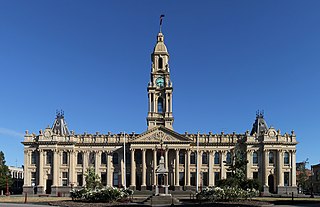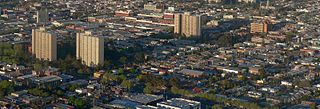
An apartment, flat, or unit is a self-contained housing unit that occupies part of a building, generally on a single storey. There are many names for these overall buildings. The housing tenure of apartments also varies considerably, from large-scale public housing, to owner occupancy within what is legally a condominium, to tenants renting from a private landlord.

Docklands, also known as Melbourne Docklands, is an inner-city suburb in Melbourne, Victoria, Australia, 2 km (1.2 mi) west of Melbourne's Central Business District, located within the City of Melbourne local government area. Docklands recorded a population of 15,495 at the 2021 census.

South Melbourne is an inner suburb in Melbourne, Victoria, Australia, 3 kilometres (1.9 mi) south of Melbourne's Central Business District, located within the City of Port Phillip local government area. South Melbourne recorded a population of 11,548 at the 2021 census.

Collingwood is an inner-city suburb in Melbourne, Victoria, Australia, 3km north-east of the Melbourne central business district, located within the City of Yarra local government area. Collingwood recorded a population of 9,179 at the 2021 census.

Fitzroy is an inner-city suburb in Melbourne, Victoria, Australia, 3 km (1.9 mi) north-east of the Melbourne central business district, located within the City of Yarra local government area. Fitzroy recorded a population of 10,431 at the 2021 census.

Fitzroy North is an inner-city suburb in Melbourne, Victoria, Australia, 4 km (2.5 mi) north-east of the Melbourne central business district, located within the Cities of Merri-bek and Yarra local government areas. Fitzroy North recorded a population of 12,781 at the 2021 census.

Carlton is an inner-city suburb in Melbourne, Victoria, Australia, three kilometres north of the Melbourne central business district within the City of Melbourne local government area. Carlton recorded a population of 16,055 at the 2021 census.

Parliament House is the meeting place of the Parliament of Victoria, one of the parliaments of the Australian states and territories.

East Melbourne is an inner-city suburb in Melbourne, Victoria, Australia, 2 km (1.2 mi) east of Melbourne's Central Business District, located within the City of Melbourne local government area. East Melbourne recorded a population of 4,896 at the 2021 census.

Brian Leslie HoweAO is a retired Australian politician and Uniting Church minister. He served as the eighth deputy prime minister of Australia and the deputy leader of the Labor Party from 1991 to 1995, under Bob Hawke and Paul Keating. He was a government minister continuously from 1983 to 1996, and a member of the House of Representatives from 1977 to 1996, representing the Division of Batman in Victoria.

Richard William Wynne is a former Australian politician. He was a Labor Party member of the Victorian Legislative Assembly from 1999 to 2022, representing the electorate of Richmond. He served as the Minister for Planning between December 2014 and June 2022 and the Minister for Housing between November 2018 and June 2022. He also served as Minister for Multicultural Affairs between November 2018 and March 2020.

In the Victorian political system, the State Minister for Housing is a State Government cabinet position responsible for Housing. The Minister for Housing is responsible for the Office of Housing ; and is one of six state ministers responsible for the Victorian Department of Families, Fairness and Housing (DFFH).

Public housing in Australia is one part of social housing and the other is community housing. Public housing is provided by departments of state governments. Australian public housing operates within the framework of the Commonwealth-State Housing Agreement, by which funding for public and community housing is provided by both federal and state governments. According to the 2006 census, Australia's public housing stock consisted of some 304,000 dwellings out of a total housing stock of more than 7.1 million dwellings, or 4.2% of all housing stock.
The Carlton Association was a community action group that campaigned on behalf of residents of the suburb of Carlton in Melbourne, Australia, between the years 1969 and 1993. The group was involved in protests against some of the most controversial redevelopment plans in the city’s history and was arguably the most politically successful residents’ action group that Melbourne has seen.
Frederick Oswald Barnett (1883–1972) was an Australian social reformer. He was responsible for raising public awareness of inner-city poverty and leading the campaign for improved housing conditions.

Terrace houses in Australia began to be built in early 19th century Sydney, closely based on the models found in London and other UK cities. They soon developed unique features, particularly elaborate balconies, and became a very popular form of housing right through the Victorian era, with some still built in the Edwardian period. Large numbers of terraced houses were built in the inner suburbs of the two large Australian cities, Sydney and Melbourne, mainly between the 1850s and the 1890s, with some examples in the smaller cities and towns.
Marcus Barlow (1890–1954) was a prominent Australian architect in the interwar period, who designed a number of notable central city buildings in his home-town of Melbourne. He is best known for the 1932 Manchester Unity Building, whose Gothic corner spire dominates the major intersection of the city.

Brigadier Sir Bernard Evans, was an Australian army officer, architect, builder and Lord Mayor of Melbourne (1959–1961).

The architecture of Melbourne, the capital of the state of Victoria and second most populous city in Australia, is characterised by a wide variety of styles in various structures dating from the early years of European settlement to the present day. The city is particularly noted for its mix of Victorian architecture and contemporary buildings, with 74 skyscrapers in the city centre, the most of any city in the Southern Hemisphere.
Renate Thelma Howe is an Australian academic and historian. Her research and writing focuses on Australian social, urban and religious history.

























